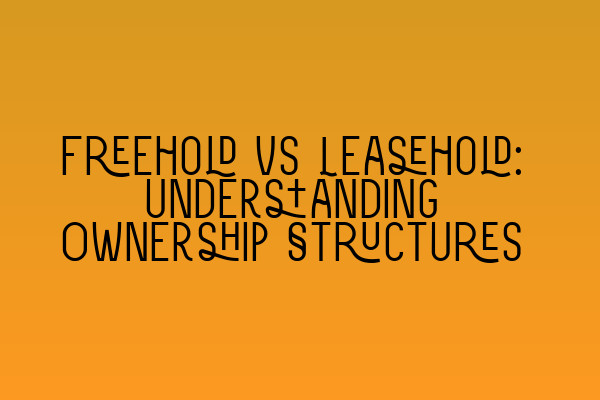Freehold vs Leasehold: Understanding Ownership Structures
When it comes to property ownership, there are two main structures: freehold and leasehold. Understanding the differences between these two types of ownership is essential whether you’re considering purchasing a property or providing legal advice to clients. In this article, we will delve into the intricacies of freehold and leasehold ownership to help you better understand their nuances.
Freehold Ownership
Let’s begin by exploring freehold ownership. In a nutshell, freehold ownership grants the owner complete ownership of the property and the land it sits on. This means that the owner has full control over the property, giving them the freedom to use, modify, or sell it as they see fit. Freeholders have the advantage of long-term security and independence, making it an attractive option for many.
One of the key benefits of freehold ownership is that there are no time restrictions. Unlike leasehold ownership, freehold ownership does not come with an expiration date. Consequently, freeholders do not have to worry about their ownership rights expiring or having to pay ground rents to a landlord.
It’s worth noting that while freeholders have greater control over their property, they are also responsible for all costs and maintenance. This includes repairs, renovations, and any other expenses associated with the property. It’s important for freeholders to be financially prepared for any unforeseen costs that may arise.
If you’re considering purchasing a freehold property, it is advisable to conduct thorough due diligence, including researching any potential restrictions or covenants that may apply to the property. Additionally, seeking legal advice from a property law expert can provide invaluable guidance throughout the purchasing process.
Leasehold Ownership
In contrast to freehold ownership, leasehold ownership involves leasing a property for a fixed period of time. The leaseholder essentially buys the right to occupy the property for the duration of the lease, typically ranging from 99 to 999 years. At the end of the lease, ownership reverts back to the freeholder unless a lease extension is agreed upon.
Leasehold ownership is most commonly associated with residential flats, where multiple leaseholders coexist within a building. In these cases, the freeholder typically has responsibility for the maintenance and management of the building, which is funded through service charges paid by the leaseholders.
Under leasehold ownership, leaseholders are subject to certain restrictions and obligations outlined in the lease agreement. This may include obtaining permission from the freeholder for alterations to the property or paying ground rents and service charges.
A potential downside to leasehold ownership is the limited control over the property. Leaseholders are bound by the terms of the lease and must adhere to any restrictions imposed by the freeholder. This can sometimes pose challenges when it comes to making modifications to the property or even selling it.
Before entering into a leasehold agreement, it’s crucial to carefully review the terms of the lease and seek legal advice to fully grasp your rights and responsibilities as a leaseholder.
Conclusion
Both freehold and leasehold ownership structures have their own advantages and considerations. Freehold ownership provides long-term security and complete control over the property, while leasehold ownership offers more affordable options and shared responsibility within a communal building.
Whether you’re buying a property or providing legal advice, understanding the nuances between freehold and leasehold ownership is vital. Conducting thorough research, seeking professional guidance, and being fully informed about the rights and responsibilities associated with each structure will help you make informed decisions and provide accurate advice.
For further resources on SQE preparation, please check out the following related articles:
